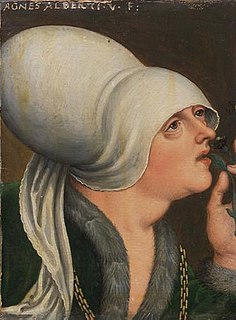Related Research Articles

The Congress of Gniezno was an amical meeting between the Polish Duke Bolesław I the Brave and Emperor Otto III, which took place at Gniezno on 11 March 1000. Scholars disagree over the details of the decisions made at the convention, especially whether the ruler of Poland was pledged the king's crown or not.
Gertrud of Brunswick was Countess of Katlenburg by marriage to Dietrich II, Count of Katlenburg, Margravine of Frisia by marriage to Henry, Margrave of Frisia, and Margravine of Meissen by marriage to margrave Henry I. She served as regent of the County of Katlenburg during the minority of her son Dietrich III of Katlenburg, and as regent of the County of Northeim during the minority of her son Otto III of Northeim. She was also one of the leaders of the insurrections against Emperor Henry IV and his son Henry V.

Anne of Bohemia and Austria was a Duchess of Luxembourg in her own right and, as a consort, Landgravine of Thuringia and of Saxony.
Theodoric I, called the Oppressed, was the Margrave of Meissen from 1198 until his death. He was the second son of Otto II, Margrave of Meissen and Hedwig of Brandenburg.

Wenceslas I, Duke of Saxe-Wittenberg from the House of Ascania ruled from 1370 to 1388 and was a prince-elector of the Holy Roman Empire as well as Prince of Lüneburg. He was the son of Rudolf I and his 3rd wife, Agnes of Lindow-Ruppin.
Conrad of Vechta was Bishop of Verden (1400–1402/1407), Bishop of Olomouc (1408–1413), Archbishop of Prague (1413–1421), and Master of the Mint (1401–1403) and Chancellor (1405–1412) of the Kingdom of Bohemia.

Maximilian Ernest of Austria, was a German prince member of the House of Habsburg and by birth Archduke of Austria.
Wartislaw VIII was a duke of Pomerania from the House of Griffins house. He ruled in Pomerania-Wolgast from 1394 together with his brother Barnim VI. After Barnim died in 1405, he ruled alone.

Albert I, called the Proud, a member of the House of Wettin, was the Margrave of Meissen from 1190 until his death.
Louis of Meissen was a German nobleman from the House of Wettin. He was Bishop of Halberstadt and later Bishop of Bamberg, then Archbishop of Mainz and finally Archbishop of Magdeburg.
Margrave Conrad II of Lusatia, also known as Margrave Konrad II of Landsberg, was a member of the House of Wettin. He was Count of Eilenburg and Margrave of Lusatia from 1190 until his death. From 1207, he was also Count of Groitz and Count of Sommerschenburg. He was a son of Margrave Dedi III and his wife, Matilda of Heinsberg, the heiress of Sommerschenburg.
Agnes of Landsberg was a German noblewoman. She was the third child of Conrad II (1159–1210), Margrave of Lusatia, and his wife, Elisabeth, the daughter of Mieszko III the Old (1126–1202), Duke of Poland. She was a daughter-in-law of Henry the Lion.

The Great Gandersheim Conflict was a conflict between the Archbishops of Mainz and the Bishops of Hildesheim concerning the jurisdiction over Gandersheim Abbey. It lasted from 987 to 1030, during the reign of the Ottonian emperors Otto III and Henry II as well as of their Salian successor Conrad II.
The Udonids (Udonen) were a German noble family, ruling as both the Counts of Stade and Margraves of the Nordmark, or Northern March, from the 9th to the 12th century. The first formal member of this family was Henry I the Bald, who took his seat in Harsefeld, part of the Duchy of Franconia, where he built a castle in 965. He was the grandson of the first Count of Stade, Lothar I, who was killed by the Great Heathen Army in the Battle of Ebstorf, and was recognized as one of the Martyrs of Ebsdorf by the Catholic Church.
John IX of Haugwitz was Bishop of Meissen from 1555 to 1559 or 1581.

Johannes Hoffmann von Schweidnitz was a Roman Catholic theologian, Professor of Theology and Rector at both Prague and Leipzig Universities, and served as Bishop of Meissen from 1427 until his death.
Saint Burchard of Meissen was the first Bishop of Meissen, from 968.
Eido I, also Ido, Eid or Ägidius, was the bishop of Meissen from 992 to 1015.
Albrecht I of Meissen was Bishop of Meissen from 1150 to 1152.

Siegfried I of Ballenstedt, was the son of Adalbert II of Ballenstedt, and a member of the House of Ascania. He was count palatine of the Rhineland (r.1095/7-1113), and count of Weimar-Orlamünde (r.1112-1113).